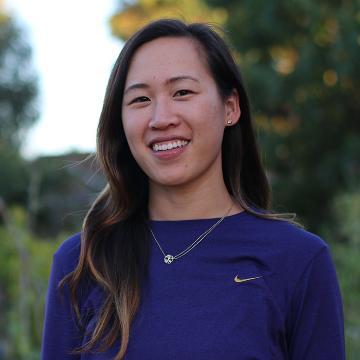
Wasteless Wonderland
Just in time for the most wonderful—and wasteful—time of year, Santa Clara University is strengthening its commitment to building a more sustainable future. Earlier this month, SCU was declared the $100,000 winner of Hyundai’s Fill It Forward Challenge over Loyola Marymount University and Pepperdine University by filling 60,022 reusable water bottles instead of using disposable plastic counterparts. Together, the three California universities reduced nearly 4,000 pounds of waste.
That’s a big pile of garbage that never materialized, which is worth celebrating, says Cara Uy-Segal ’11, MBA ’19, the interim director of SCU’s Center for Sustainability who worked closely with University Operations to facilitate the challenge and help fund the Sustainability Strategic Plan. Still, it pales in comparison to the 25 million tons of waste generated in the U.S. between Thanksgiving and New Year’s Day.
“It can be scary, overwhelming, or simply frustrating to see numbers like that,” Uy-Segal says; but that’s no reason to give up. “It’s easier to focus on my individual impact on affecting change when it comes to environmental concerns and sustainability.” Here, she offers some insights and ideas into making more manageable sustainability goals this holiday season.
A lot of big numbers are thrown around this time of year when it comes to the amount of waste generated by decorations, party-hosting, gift-giving, etc. What’s one number that particularly resonates with you?
The US Postal Service is projected to deliver more than 900 million packages and 15 billion pieces of mail during the holiday season. Meanwhile, last year, Amazon reported delivering 1 billion “free” holiday items to Prime customers in the U.S. and, in 2017, more than 5 billion holiday items worldwide. That’s a lot of packaging that might not be recyclable or gets thrown in the trash.
With e-commerce dominating as the chosen method for shopping, my wish is that manufacturers would decrease the amount of packaging per purchase. I think it would be really cool if Amazon could combine all items in your shopping cart into just one box instead of individual boxes, especially if it’s all small items! Moreover, many retail stores offer a pick-up option in which you pick up your purchase in person, cutting down on the cardboard and plastic stuffing needed for shipping.
What about wrapping those gifts once we’ve brought the packages home?
That glossy wrapping paper is pretty, but it sure is wasteful! Much of it ends up in landfills because that kind of paper cannot be recycled. I prefer to wrap gifts simply with a bow and tag instead of paper. Or I reuse beautiful bags I’ve received in the past. This rids the gift recipient of worry and guilt of having to properly discard of the wrapping materials. Another idea is to reuse paper from around the house like newspaper, maps, or old posters. Make it a holiday art project by drawing or coloring on paper bags in place of gift wrap.
Let’s talk about gift-giving. How can we change up gift-giving traditions to have a more sustainable holiday?
Get back to the roots of holiday tradition. Kids write letters to Santa, sharing their good deeds and wish lists. Why can’t we adults do something similar? Family wish lists can be written on one piece of paper hung up by the tree or, if you’re spread out across the world, on a shareable online file. That’s what I do now, and give access to all family members I am seeing during the holidays. Check off an item when it’s been purchased to avoid doubling up. Even better, give experiences instead of stuff. Think: museum passes, movie or concert tickets, yoga classes, or a massage gift certificate.
Also consider doing a Secret Santa or White Elephant exchange in order to avoid over-gifting and, therefore, more wasteful packaging and materials. If you have kids at the family gathering, or adults who are young at heart, you can hide unwrapped gifts around the house for a Christmas scavenger hunt instead of piling wrapped boxes under a tree.
What about New Year’s? How can we be more sustainable in 2020?
Strive for simplicity in your home. I used to love cleaning and organizing—it made me feel like I had control over my busy life. But then I realized that if I have less stuff to clean and organize, I get more time for activities that are life-giving and offer me net positive energy.
Say “no” more often. This can be about material items you do not need or tasks in your daily life that drain you rather than energize you.
Extend the life of a product by finding multiple purposes for it before it needs to be discarded. I always play this scenario in my head before purchasing anything. Whether it’s an outfit or a household item, I try to imagine how many uses I will realistically get out of it. The second thing I ask myself is if there is an alternative route. For example, can I borrow the item instead of buying it? Can it be reused or repurposed for something else later on?
What is Santa Clara University doing in the new year sustainability-wise that we can learn from at home?
For one week this fall, the Center for Sustainability partnered with Kristin Kusanovich, of the Center for Arts and Humanities, on the tUrn project to engage people across campus in turning our attention toward the climate crisis. We are replicating this week in April 2020 during the 50th anniversary of Earth Day. In the meantime, there is a tUrn resource guide that anyone can view to catch up on what’s been happening with the climate crisis, to support and be a part of organizations at Santa Clara and beyond that are working on solutions—or to pull examples or conversation starters from—to share with family members over holiday dinners.

